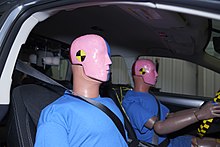
A crash test dummy, or simply dummy, is a full-scale anthropomorphic test device (ATD) that simulates the dimensions, weight proportions and articulation of the human body during a traffic collision. Dummies are used by researchers, automobile and aircraft manufacturers to predict the injuries a person might sustain in a crash.[1] Modern dummies are usually instrumented to record data such as velocity of impact, crushing force, bending, folding, or torque of the body, and deceleration rates during a collision.[2]
Prior to the development of crash test dummies, automobile companies tested using human cadavers, animals and live volunteers.[3] Cadavers have been used to modify different parts of a car, such as the seatbelt.[4] This type of testing may provide more realistic test results than using a dummy,[5] but it raises ethical dilemmas[6] because human cadavers and animals are not able to consent to research studies. Animal testing is not prevalent today.[7] Computational models of the human body are increasingly being used in the industry and research to complement the use of dummies as virtual tools.[8][9]
There is a constant need for new testing because each new vehicle has a different design, and as technology changes ATDs must be developed to accurately test safety and efficacy.
- ^ Nick Kurczewski (2011-01-20). "Smart Crash Test Dummies – The Latest Car Safety Tech – RoadandTrack.com". Road & Track. Retrieved 2 June 2015.
- ^ "How Crash Testing Works". 2 March 2001.
- ^ "The Humble History of the Crash Test Dummy". 4 August 2019.
- ^ Cite error: The named reference
:2was invoked but never defined (see the help page). - ^ Marquis, Erin (2018-10-31). "How Dead Bodies Save Lives Every Day on the Road". Jalopnik. Retrieved 2023-02-01.
- ^ Cite error: The named reference
LA Timeswas invoked but never defined (see the help page). - ^ Cite error: The named reference
new yorkwas invoked but never defined (see the help page). - ^ CORPORATION, TOYOTA MOTOR. "Toyota Updates its THUMS Virtual Crash Dummy Software | Corporate | Global Newsroom". Toyota Motor Corporation Official Global Website. Retrieved 2020-04-02.
- ^ "Home". GHBMC. Retrieved 2020-04-02.